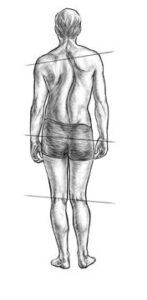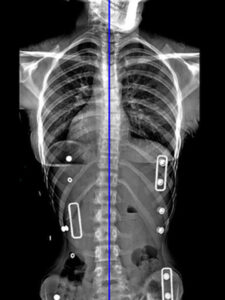A TLSO brace or a scoliosis brace helps to treat the spine by applying corrective pressure in a way that’s comfortable for the patient. Pressure that is spread out over the course of the tlso as well as a couple spots where more correction can be added for positive purposes. This should not in any way hurt the patient.
 Scoliosis is marked by curvature and rotation of the spine. As well as uneven hips and shoulders potentially. Moreover, a person can have a prominent rib hump as well due to the spinal curvature.
Scoliosis is marked by curvature and rotation of the spine. As well as uneven hips and shoulders potentially. Moreover, a person can have a prominent rib hump as well due to the spinal curvature.
Basically, what you want to do is straighten out the curve for the patient and you do that with
A) Pads That Are In The TLSO
B) Correction During The Casting Visit
During the casting, or in the correction phase of the impression process a lot of good things can happen. An orthotist (brace specialist) can help correct someone’s spinal curvature in the casting or in the scanning phase of a scoliosis brace.
It is important to do some correction in the casting phase because it will let the orthotist know how much correction a person is comfortable with. – Another thing you can do is augment that casting correction with some well placed pads that are meant to support the spine.
A positive outcome with scoliosis is taking a curve and reducing it by 50%. However, as you can see in the picture below, much more correction is possible when everyone is on the same page and being present for follow up visits.

What type of pads go into a scoliosis TLSO?
There’s usually a lumbar pad – the lower part of the spine inside of the brace and there can be a thoracic pad. There are usually two pads if there is an S curve, i.e. the left lumbar, right thoracic curve. But if there is a single curve you might not need two pads, for example; just one can suffice.
TLSO Extensions
A scoliosis TLSO can also have something called a trochanteric extension as well as an axillary extension. Axillary, in non medical speak, just means up into the armpit. To the point that the patient can tolerate this extension. (This is a uniform method of treatment and not just something our office promotes.)
These extensions we just mentioned are to help address what is known as scoliotic decompensation. Decompensation, is not so much the curve itself but rather the shifting of the curve from center to the right side or the center to the left side.
The brace is and should be a negative replica of the person’s body in a corrected state. As we mentioned before, you can also add pads to that corrected state, to push on the spine a little bit more.
You don’t do it to the point where the patient can’t tolerate it, because obviously then they wouldn’t wear the brace. Some patients have a higher threshold for curve correction than others. But if someone can not tolerate a lot you can start conservatively and work on adding 1/4″ to the pads over time. An orthotist doesn’t want to push the patient too far for obvious reasons.
How Do Scoliosis Braces Open?
Many times a brace like this can open in the front. That’s the way we do them as we don’t want to lock someone into their treatment. They used to make them a lot where they open in the back, which did also treat the diagnosis but made the patient feel like (as stated earlier) that they’re locked into the brace.
It is never our goal to make a person feel comfortable with the scoliosis brace or have them not want to wear it.
There are different styles of the brace; some people argue that it’s only the posterior opening ones that are most effective, which is highly debatable. The anterior opening ones can be very effective.
You’re not going to take a whole lot of these x-rays with scolisos orthosis on but when you do, it is extremely important to put it on the right way or you are wasting your time and money.
The Importance of A Good In Brace X-ray
You have to get a good idea of what the brace is doing for yourself or your son or your daughter, and make sure you put the brace on the right way.
One of the ways that we tell people to apply the brace at Rinella is to apply it, or – at least make it snug – when the person is lying down. When a person sits up, they tend to shrink a little bit. They curl up. But their impression was definitely not made with them sitting so you can see how the brace that is designed to fit a straight torso has to fight a sitting position and its hard to be truly effective that way. – When you curl up just a few inches, so does your spine. And when you curl up a little bit, your belly gets a little bit bigger as well. This means you do not get the compression in the abdomen as much which helps to straighten out the curve (just one of many biomechanical principles involved in treating scoliosis from an orthotic standpoint).
You can even lengthen out more and your circumferences can reduce even further when you lay down. Which is how we recommend people apply their scoliosis TLSO. We try to ask people to apply it laying down if they can, or at the very least tighten it lying down to the point where you feel snug, or to the point where you can tolerate it.
In Summary
A scoliosis TLSO helps to correct the spinal curvature present. The corrected state can be augmented by the implementation of the brace. It is important to remember however that you apply the brace to the patient and also the person to the brace so application is vital to the process.
We hoped this blog post helped you. Make sure to check out our other videos for helpful free information about scoliosis, foot drop, prosthetics and more!
Thanks for reading / watching our post.
